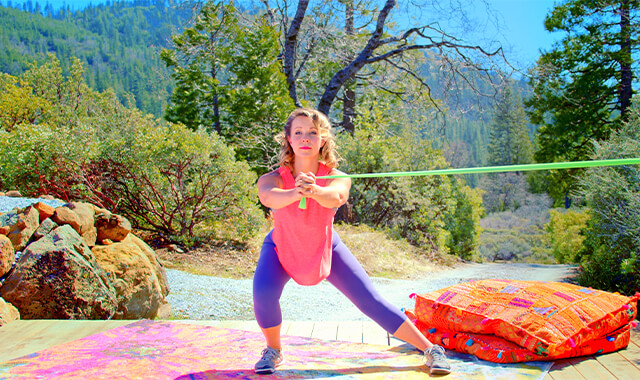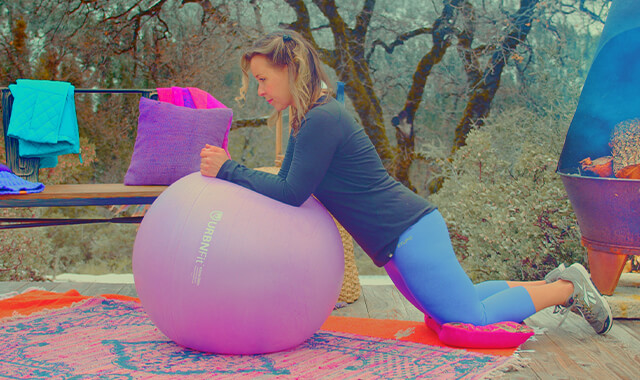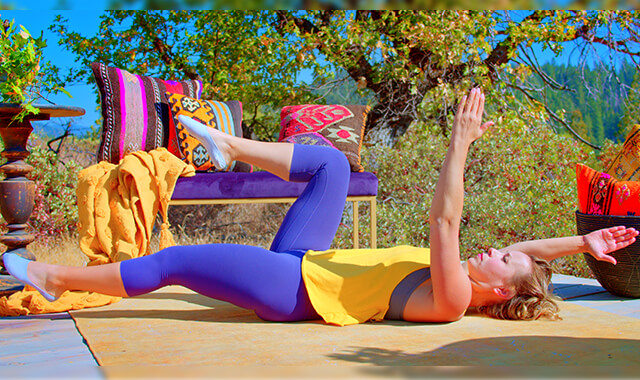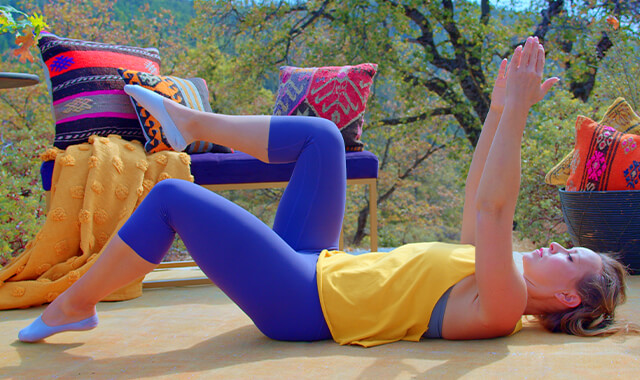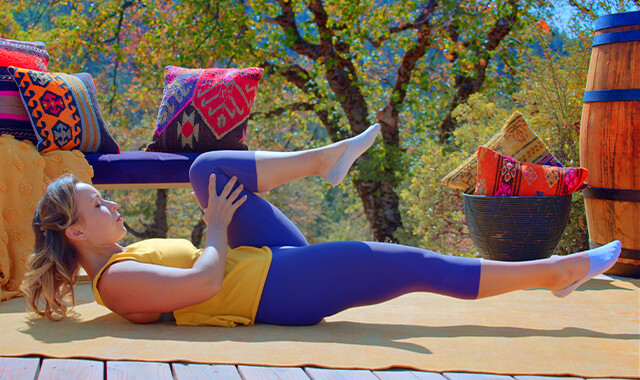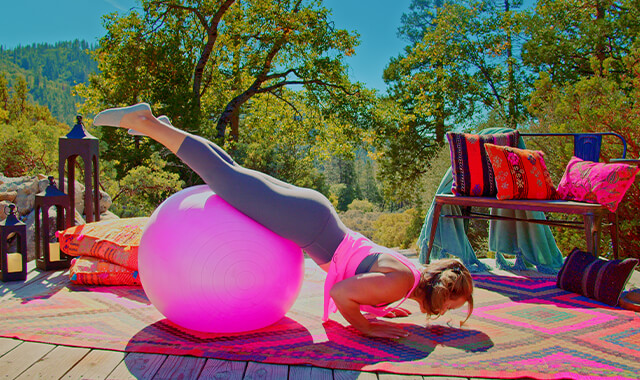Transverse Abdominis (TA) Core Muscle Activation
How to Do the Supine Transverse Abdominis (TA) Activation (Core) | In-Depth Guide [VISUAL LEARNERS] Beginner
Proper Form & Common Mistakes | Home Resistance Training
WHAT DO YOU WANT TO SEE?
MUSCLES THIS WORKS
MUSCLES
MAIN MUSCLES WORKED IN Transverse Abdominis Activations
TRANSVERSE ABDOMINIS, OBLIQUES, & RECTUS ABDOMINIS
OTHER MUSCLES WORKED:
- Pelvic floor
- Diaphragm
STARTING POINTERS
Starting Pointers
WHAT WE'RE DOING TODAY
ALL WE'RE DOING:
Watch the video to get a feel for engaging this deep important core muscle.
This is a fundamental exercise used for finding and voluntarily activating the deep abdominal muscle - the transverse abdominis. The ability to activate this muscle is key to being able to do core muscle exercises with proper form. This muscle is important for training the core muscles to stabilize before moving the arms or legs. The timing of the muscle activation is critical to protect the spine. The muscles need to anticipate movement. This exercise is the first step in gaining control over this important muscle. Knowing how to engage this muscle is what will teach you how to use/engage your core muscles during exercise, without gripping them tightly.
In daily life, including exercising, it is not really possible to isolate one or two of the core muscles, they all work together to stabilize your core. The reason that it is so important to learn to activate the transverse abdominis muscle is because we tend to activate our rectus abdominis (6-pack muscle) without the transverse abdominis. Maybe this is due to years of being taught to flatten our backs against the floor and doing sit up and leg lifts incorrectly. Whatever the reason, people are unaware of their transverse abdominis muscle and have a hard time activating it. The transverse abdominis muscle is one of the most important stabilizing muscles.
Contracting the transverse abdominis muscle should feel like you are just snugging up the midsection, you gently engage the muscles, don’t over-tighten or grip. Most people tend to contract the muscle too much. You should be able to breathe and talk.
When you are exercising the core muscles you will be doing rib/thoracic breathing as opposed to diaphragm breathing. When your core is not working to stabilize against a force, you inhale using the diaphragm. The muscle moves down and the lungs expand, exhaling when the diaphragm moves up. With rib breathing the diaphragm is not as active, the ribs expand (moving out to the sides) to allow the air into the lungs and move together to help with exhalation.
HOW TO DO THE EXERCISE
LOOKS
HOW Transverse Abdominis Activations SHAPE OUR BODY
Flat stomach, toned and tapered waist, improved posture, confident, graceful movement.
PROPER FORM
PROPER FORM: Transverse Abdominis Activation
EQUIPMENT, SETS & REPS
EQUIPMENT
- Mat
SUGGESTED STARTING WEIGHT FOR WOMEN:
None
SETS & REPS:
5-10 sets, once a day until you are able to actively contract the muscle in sitting, standing and lying on your back.
PACE:
Contract and hold for 3-5 seconds.
BODY POSITION
BODY POSITION FOR THE Transverse Abdominis Activation
BODY STANCE: Lie on your back, knees bent with feet flat on the floor. Neutral spine, shoulders relaxed to the floor.
ARMS: By your sides, hands resting on lower abdominal area to monitor muscle activity.
HOW TO DO
HOW TO DO Transverse Abdominis Activations
CUE: This exercise is for activating your transverse abdominis muscle - connecting the mind and body - not for strength gains.
Feel the front of your pelvis – there should be a part that sticks out a little bit more – one on each side.
Drop your fingers down on to your soft abdomen – keep the fingers close to the bone
Imagine pulling the bones in towards your belly button
Clear your throat and you should feel the muscle activate under your fingertips – that is the lower part of the transverse abdominis
Lift your pelvic floor.
Imagine pulling your lowest abdominal muscles (from the belly button down to the pubic bone) up and in – as if you were trying to put on a pair of tight pants.
To activate the abdominal muscles up by the lower ribs and breastbone: Imagine pulling your ribs on the left and right towards each other
When you are activating your transverse abdominis correctly you will be able to feel the muscle tension under your fingers, it should not be tight or gripping – just active. The muscle should not push up under your fingers or cause your stomach to bulge.
When you are activating the muscle correctly – your spine and pelvis will stay still -no movement. Your ribs should not move down towards your pelvis or flare out (The lower ribs 7-12 stay fairly still and 1-6 will move laterally as you inhale. Moving down or flaring out usually implies spinal flexion (down) and extension (flaring).) Your transverse abdominis originates (in part) on the lower 6 ribs in the back, surrounds the torso and attaches to the fascia in the front. When your transverse abdominis muscle is activated it can pull the lower ribs in a tiny bit - your lower left and right ribs in towards each other. Any actual movement is minimal but it helps give the sensation of cinching up a corset or shrink wrapping your midsection - all the way around.
A note from Carol the Physical therapist after I asked a question related to keeping this muscle engaged while breathing (that's hard to understand right??) she shared that "the TA along with some of the other core muscles act to compress the midsection and this increase in abdominal pressure is what helps to stabilize the spine but I didn't fully understand since it is possible to do chest breathing during core work! After a bunch of reading it seems that the TA is kind of intertwined with the diaphragm. So I think the lower ribs are fairly stable when it is contracted but the upper ribs - about 7 and above, are free to move laterally as the lungs expand."
Basically she's saying it IS possible to breathe higher up in our chest while still keeping our transverse abdominus muscle active, which is weird. :)-
Work on inhaling and on the exhale contract the muscle – hold for 3 seconds and then repeat about 5 -10 times at least once a day for 2-3 weeks. Progress to activating the muscle in sitting and standing.
Make sure that you are not substituting with other muscles:
- Diaphragm – make sure you are not holding your breath
- When you are monitoring just inside the front of your pelvic bones – your fingers are pushed up when you contract your muscle – this means that you are using the obliques instead of the transverse abdominis
- The stomach bulges out – If the front on your stomach pooches out, you are using the rectus abdominis muscle (the 6-pack muscle that flexes the spine).
- Rolling your pelvis back (and flattening the back) or pulling your ribs down – this means you are activating your rectus abdominis or gluteus maximus.
HOW TO SAFELY GET OUT OF THE EXERCISE
Roll to your side, press up to standing.
COMMON MISTAKES
COMMON MISTAKES
WHAT TO AVOID WITH THE Transverse Abdominis Activation
KEY TIP:
Guess what? Good news! Many avoids are the same for most movements. Once you learn the basics, there's really only a few extra avoids for each individual movement.
1. Avoid Holding your Breath
AVOID: Avoid holding your breath.
WHAT TO DO:
- When first learning core exercises it can be difficult to keep the abdominals activated and continue a normal breathing pattern.
- Inhaling and exhaling will increase the core muscle activity, and bring oxygen to the muscles as they work.
- It is helpful to work on abdominal muscle activation coordinated with breathing before adding the leg movement.
2. Avoid Pushing Muscles Out
AVOID: Avoid letting your abdominal muscles bulge out.
WHY NOT?
- This is the most common mistake.
- You should not see your lower abdomen pooch or bulge out when the abdominal muscles are active.
- This means that you are pushing your rectus abdominis (6-pack muscle) out instead of using your transverse abdominis to stabilize your midsection.
WHAT TO DO:
- This most frequently happens when you are first lifting the legs or when your core muscles get tired.
- Make sure to lift one leg at a time, concentrating on pulling the belly down towards the spine without flattening your low back.
- Correct activation of your abdominal muscles will result in a flat or slightly “scooped” out appearance of your lower abdominals.
- If you are unable to activate your abdominals without them bulging out
- Work on pulling your belly button down towards your spine in a hook lying position (feet on the floor, knees bent)
- Add in controlled breathing while maintaining the position.
- Master this exercise before progressing core exercises.
3. Avoid Flattening Low Back
AVOID: Avoid flattening your low back.
WHAT TO DO:
- Maintain a neutral spine position to prevent injury or muscle strain.
- You should not be able to feel your low back pressed into the floor.
- Work on activating your core muscles without flattening your low back.
WHAT WE'RE DOING TODAY
WHAT & WHY
BENEFITS OF TRAINING THE core muscles
WHAT
LAYING DOWN EXERCISES YAY
This is one of my favorite core exercises. I will probably end up writing this on every core exercise blogpost, but core exercises have changed the strength of my body a LOT. I am able to have a good comparison because, welp, embarrassingly I never did them before at all. I didn't really understand their value so I skipped them. I feel so different in my body when exercising and doing daily life now that these movements have been a part of my regular workout routine.
These movements are done lying down on your back, making them a nice way to start or end your day. Lying down lets you concentrate on activating the abdominal muscles without worrying about the back muscles. These exercises seem pretty simple but they can be very challenging and do a great job of activating the core.
MAIN MUSCLE WE ARE TRYING TO ACTIVATE
It is important to really understand and feel the abdominal muscles working the way they are supposed to work. The main muscle you are trying to activate is the transverse abdominis which is deep - deeper than the rectus abdominis (6-pack) muscle. This is the corset muscle - it is attached to the ribs, the pelvis, iliopsoas, and connective tissue in the front of the torso, and wraps around your midsection to join the fascia that attaches to the back muscles. When activated it feels like you have shrink-wrapped your mid-section, just like cinching up a corset or back brace. If you have never heard of this muscle before and have no idea how to activate it, start with the Transverse Abdominis Activation exercise before moving on to the others.
The key to the core exercises is being able to find and activate this muscle. The transverse abdominis muscle runs across your midsection, from the ribs to the public bone, around the sides of the torso, and attaches to the spine through fascia, it is like a big back brace. It is one of the most important spinal stabilizers, unfortunately, many people are not even aware of it and they don’t know how to activate it. A bonus is to be able to activate the pelvic floor muscles at the same time. This will take time and concentration. The biggest mistake people make is that they are not patient enough to make sure they are using the correct muscles and they progress the exercises too quickly. This set of exercises is designed for making it easy to feel the correct muscles working.
WHY BOTHER DOING IT?
WHY
WHY DO WE EVEN CARE?
Core exercises should be considered the foundation for all exercises - you must be able to stabilize your midsection to be able to use your arms and legs in a healthy and effective way.
TYPE OF CORE EXERCISES MATTER
Exercises like sit ups, crunches or Russian twists, involve holding the legs and arms still and moving the low back (lumbar spine) over and over again. Sometimes this is even done while holding weight. This type of movement trains the muscles to move through the spine. This type of exercise, bending over & over at the spine, will actually weaken the tissues that support the spine, the ligaments and discs. These exercises work the rectus abdominis muscle which acts to bend the back (flex), it does not stabilize the spine, it does not even attach to the spine.
Exercises that train our core muscles to stabilize the spine instead of moving the spine helps to prevent damage to the low back. This is what most physical therapists will tell you.
HELPS HAVE THE STRENGTH, BALANCE & COORDINATION NEEDED TO DO EVERYTHING BETTER & MORE EFFICIENTLY
Unfortunately, a very high number of people in the U.S. will have back pain at some point in their lives. Also, once you start lifting weights to increase the strength of your legs and arms, or increase your activity to include heavy work like shoveling, you want to be sure that your core muscles are strong enough to keep up.
Strong and healthy abdominals impact just about everything we do in our daily lives. When the abs are stronger you can move with less effort, lift more, carry more, and walk and bike further. The core muscles are the center of the body - they all work together to coordinate the lower and upper body and the left and right sides of the body. Healthy core muscles will improve balance and coordination.
Learning how to move and exercise with good form will help prevent back pain, and if you injure your back, having good core strength will help you recover more quickly. Core exercises will increase the strength of your core, but more importantly, the exercises train the muscle how to do their job. Their job is to make subtle coordinated changes constantly in order to hold and move the body. These exercises train the muscles of the torso for endurance, strength, and motor control (the ability of the muscles to work together to stabilize the trunk as the arms and legs are moving). Many people are unsure of how to activate their core muscles, especially the transverse abdominis. The main job of the transverse abdominis is to compress and stabilize the midsection. The core muscles need to work together all day long, in a highly coordinated fashion to keep us upright during all of our daily activities.
If you have ever had back pain or an injury, complex pregnancies and/or deliveries, pelvic floor pain, abdominal surgery, including cesarean sections - sometimes the transverse abdominis is not responsive. It is not uncommon for muscles to “shut down” after pain or injury. And in the case of abdominal surgeries, it is necessary to get through these muscles. Different surgeons have different approaches, but to get through to the contents of the abdomen, you must get through the muscles, so the muscles have been injured. After the surgery or trauma, the muscles need to be re-educated, to learn to do their job. This is no different than rehabilitation after a sprain, strain, or tear of the other muscles in your body.
Untrained core muscles don’t always cause back or neck pain, when the core is not stable, it affects the way we use our arms and legs. Poorly trained core muscles can cause hip, knee, ankle, foot, shoulder, and arm pain or injury.
These exercises focus on activating the muscles that compress the abdomen. The muscles support and protect the internal organs, including the liver, stomach, intestines, and bladder. Increasing the intra abdominal pressure by activating the muscles improves the function of the internal organs including digestion, bladder and bowel control, and breathing.
EVERYDAY LIFE
EVERYDAY LIFE &
MUSCLE FUNCTION
HOW WE USE OUR Core MUSCLES IN EVERYDAY LIFE
1. THE TRANSVERSE ABDOMINIS, AND OBLIQUES WORK ALL DAY LONG TO STABILIZE THE SPINE DURING DAILY ACTIVITIES:
- Walking
- Running
- Dancing
- Lifting
- Pulling
- Carrying
- Pushing a wheelbarrow
- Washing windows
- Kicking or throwing a ball
- Reaching
- Climbing stairs/ladder
- Stepping into a high car/truck
- Golf
- Painting overhead
- Vacuuming
- Sweeping
- Gardening
2. THE RECTUS ABDOMINIS FLEXES THE SPINE
- Sitting up from lying down - like getting out of bed
- Prevents you from falling backward - balancing on a ladder while washing windows or painting.
3. THE TRANSVERSE ABDOMINIS, OBLIQUES, DIAPHRAGM, AND PELVIC FLOOR COMPRESS THE ABDOMEN
- Going to the bathroom
- Coughing
- Sneezing
- Laughing
- Supports the internal organs for improved function - especially digestion
HOW TO FEEL WHAT MUSCLE IS WORKING
How to Feel What Muscle is Working
The most important muscle to activate for this group of exercises is the transverse abdominis muscle. This is a hard muscle to find. It is broad and deep. When you activate this muscle the belly button and spine move closer together, the ribs on the left and right sides of the front of the torso come in closer together. You should feel like you are tightening up a corset or shrink-wrapping your midsection.
Transverse abdominis: Lie on your back, knees bent. Find the two pointy parts on the front of your pelvis. Drop your fingers down off of the bony part, in the direction of your belly button. Now clear your throat. You should feel the transverse abdominis contract under your fingertips.
If you cannot find this muscle, or if you are unsure if you are doing it right, try the Transverse Abdominis Activation exercise.
SCIENCY STUFF
SCIENCY STUFF
SPIFFILICIOUS FACTS ABOUT MUSCLES & MOVES
It could be argued that it is not necessary to do specific exercises for your core muscles because you are using them all day long. This is true to some extent. If you are relatively active, with good posture, good control over your midsection, you have established healthy movement patterns - keeping your spine neutral and stable during heavy lifting or repetitive movement, and have no history of back pain, or abdominal surgery (cesarean sections, hysterectomies) or complications/difficulty in pregnancy or childbirth, then you may not have to do specific core exercises - because you are using those muscles correctly all day long.
ALLLL MUSCLES & WHEN
ALL MUSCLES WORKING & WHEN DURING Transverse Abdominis Activations
The transverse abdominis muscle is activated and relaxed.



